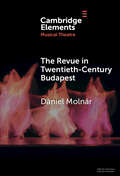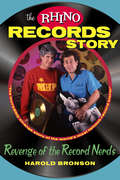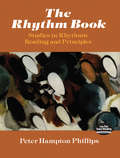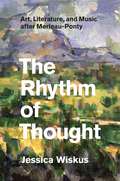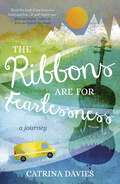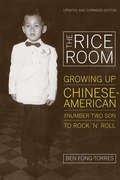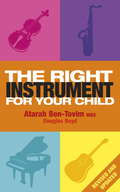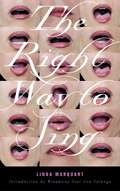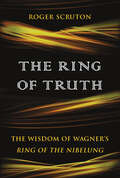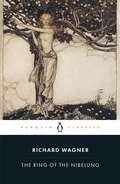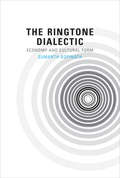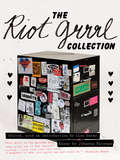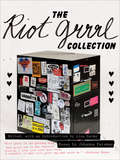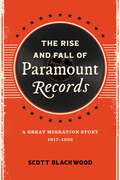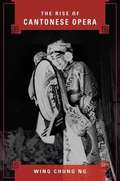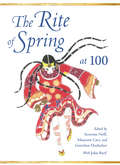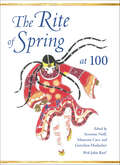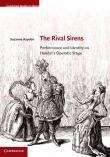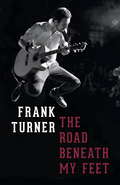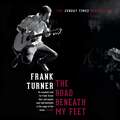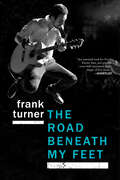- Table View
- List View
The Revue in Twentieth-Century Budapest: From Cosmopolitan Night-Clubs to Stalinist Dogma (Elements in Musical Theatre)
by Dániel MolnárSince the introduction of modern revues in 1925, the genre faced near-constant political scrutiny in Budapest. Yet by the 1930s, the city had become the capital of Central European cosmopolitan nightlife. The closure of Hungary's borders after World War II ended any hope of reclaiming this international status. Under communism and the Stalinist totalitarian regime, the revue—despite its popularity—remained politically stigmatized. For the first time, entertainment was treated as a cultural matter rather than merely a law enforcement issue, but it was forced to conform to ideological expectations. Three attempts to legitimize the genre in the 1950s ultimately failed, shaping the trajectory of live entertainment in the era. By the 1960s, revues were officially accepted, yet their cultural significance had faded amid the rise of new entertainment forms.
The Rhino Records Story: Revenge of the Music Nerds
by Harold BronsonIn the 1970s in the backroom of a record store, Harold Bronson and Richard Foos were making history-and Rhino Records was born. Harold Bronson's The Rhino Records Story tells the tale of how a little record shop became a multi-million dollar corporation. Starting as an expression of Bronson and Foos' passion for rock music, absurdity, and an anti-establishment sensibility, Rhino soon outgrew its beginnings as a reissue label, taking on new artists and new mediums. Their accomplishments grew to encompass several gold record awards, the Best Label of the Year Award, the revival of careers of famous musicians, and the creation of a company to produce feature films including Fear and Loathing in Las Vegas. This behind-the-scenes look at a company considered by many to be the industry's best, reveals the secrets to their success. Written from the perspective of cofounder Harold Bronson, The Rhino Records Story divulges a unique business approach which made Rhino what it was at the height of its success. Woven throughout this story of a rising corporation, Bronson guides us through the ascent, fall, and revival of artists Rhino touched such as the Monkees, the Turtles, the Knack, and Frankie Lymon. In a mix of hard work, passion for music, and a flair for the unconventional, the story of Rhino Records takes shape. The owners also ran their company humanely, and were awarded the Clinton administration's only Corporate Citizenship Award given to an entertainment company. Rhino Records, as it was envisioned by Bronson and Foos, had higher priorities than the bottom line. Struggling against corporate interests, rock star personalities, and a perpetual underdog reputation, Bronson provides an exclusive insight into how the industry was run and how Rhino excelled. By the fans, for the fans, Rhino Records is the story of rock history, evolving pop culture, and a unique understanding of the music that mattered.
The Rhino Records Story: Revenge of the Music Nerds
by Harold BronsonIn the 1970s in the backroom of a record store, Harold Bronson and Richard Foos were making history-and so, Rhino Records was born. Harold Bronson's The Rhino Records Story tells the tale of how a little record shop became a multimillion dollar corporation. This behind-the-scenes look at a company considered by many to be the industry's best, reveals the secrets to their success. Written from the perspective of co-founder Harold Bronson, The Rhino Records Story divulges a unique business approach which made Rhino what it was at the height of its success. In a mix of hard work and good humor, the story of Rhino Records takes shape. Struggling against corporate interests, the demands of rock star personalities, and a perpetual underdog reputation, Bronson provides an exclusive insight into how Rhino excelled. By the fans, for the fans, Rhino Records is the story of rock history, evolving pop culture, and a unique understanding of the music that mattered.
The Rhythm Book: Studies in Rhythmic Reading and Principles
by Peter PhillipsThis excellent textbook is directed to students and their teachers who want to further their mastery of rhythmic reading and notation. Through study of its principles, and through practice of the simple drills and exercises that occur throughout the book, readers can build the broad and fluent rhythmic vocabulary necessary for a good, basic understanding of music's essentials.Chapter by chapter, Peter Hampton Phillips, composer and educator, familiarizes the reader with the various signs, symbols, and units of rhythmic notation. For each area, he includes studies for playing and singing, and illuminating examples from nine centuries of music literature.The book includes a section on basic conducting technique and an appendix on sight-singing with drills that can enable singers and instrumentalists to "read ahead"; that is, to scan across the page, grasping new patterns as they appear. Other highly useful appendixes to this essential text demonstrate the principles of musical notation; illustrate a broad range of conducting patterns; list tempo markings in English, Italian, German, and French; and present typical problems and solutions of rhythmic notation.
The Rhythm of Thought: Art, Literature, and Music after Merleau-Ponty
by Jessica WiskusBetween present and past, visible and invisible, and sensation and idea, there is resonance--so philosopher Maurice Merleau-Ponty argued and so Jessica Wiskus explores in The Rhythm of Thought. Holding the poetry of Stéphane Mallarmé, the paintings of Paul Cézanne, the prose of Marcel Proust, and the music of Claude Debussy under Merleau-Ponty's phenomenological light, she offers innovative interpretations of some of these artists' masterworks, in turn articulating a new perspective on Merleau-Ponty's philosophy. More than merely recovering Merleau-Ponty's thought, Wiskus thinks according to it. First examining these artists in relation to noncoincidence--as silence in poetry, depth in painting, memory in literature, and rhythm in music--she moves through an array of their artworks toward some of Merleau-Ponty's most exciting themes: our bodily relationship to the world and the dynamic process of expression. She closes with an examination of synesthesia as an intertwining of internal and external realms and a call, finally, for philosophical inquiry as a mode of artistic expression. Structured like a piece of music itself, The Rhythm of Thought offers new contexts in which to approach art, philosophy, and the resonance between them.
The Rhythm of Thought: Art, Literature, and Music after Merleau-Ponty
by Jessica WiskusBetween present and past, visible and invisible, and sensation and idea, there is resonance—so philosopher Maurice Merleau-Ponty argued and so Jessica Wiskus explores in The Rhythm of Thought. Holding the poetry of Stéphane Mallarmé, the paintings of Paul Cézanne, the prose of Marcel Proust, and the music of Claude Debussy under Merleau-Ponty’s phenomenological light, she offers innovative interpretations of some of these artists’ masterworks, in turn articulating a new perspective on Merleau-Ponty’s philosophy. More than merely recovering Merleau-Ponty’s thought, Wiskus thinks according to it. First examining these artists in relation to noncoincidence—as silence in poetry, depth in painting, memory in literature, and rhythm in music—she moves through an array of their artworks toward some of Merleau-Ponty’s most exciting themes: our bodily relationship to the world and the dynamic process of expression. She closes with an examination of synesthesia as an intertwining of internal and external realms and a call, finally, for philosophical inquiry as a mode of artistic expression. Structured like a piece of music itself, The Rhythm of Thought offers new contexts in which to approach art, philosophy, and the resonance between them.
The Ribbons are for Fearlessness: A Journey
by Catrina DaviesDevastated by her lover leaving and trapped in a dead-end job, Catrina’s friend Andrew comes up with a plan: they'll busk their way from Norway to Portugal in a van. When Andrew is killed in a tragic accident Catrina decides to go it alone and discovers the real meaning of love and courage, and the importance of following her dreams.
The Rice Room: Growing Up Chinese-American from Number Two Son to Rock 'n' Roll
by Ben Fong-TorresAn instant best-seller when originally published in 1994, this expanded and updated edition of The Rice Room tells of growing up with a double identity—Chinese and American. Ben Fong-Torres was torn between an alluring American lifestyle—including Elvis and rock ‘n’ roll—and the traditional cultural heritage his proud immigrant parents struggled to instill in their five children. Now illustrated with personal family photographs as well as photos of the author with various celebrities, Fong-Torres rounds out his life story with a new final chapter.
The Right Instrument For Your Child
by Atarah Ben-Tovim Douglas BoydThis unique book offers a simple and practical method of selecting the right instrument for the individual child.Starting with the physical and emotional make-up of the child and using questionnaires and charts, the authors systematically explain the pros and cons of various instruments. For instance, a child who loves company might not enjoy playing the piano as it is predominantly a solo instrument. It appeals more to quiet introverts and yet many a child has been forced to learn only to give up as soon as they are allowed. As well as examining each individual instrument, the authors give advice on how some of the pitfalls can be avoided and provide information on buying and practising. Based on years of research by the authors, whose experience is unsurpassed, this is a comprehensive and inspirational book that will help unlock every child's potential.
The Right Instrument For Your Child
by Atarah Ben-Tovim Douglas BoydThis unique book offers a simple and practical method of selecting the right instrument for the individual child.Starting with the physical and emotional make-up of the child and using questionnaires and charts, the authors systematically explain the pros and cons of various instruments. For instance, a child who loves company might not enjoy playing the piano as it is predominantly a solo instrument. It appeals more to quiet introverts and yet many a child has been forced to learn only to give up as soon as they are allowed. As well as examining each individual instrument, the authors give advice on how some of the pitfalls can be avoided and provide information on buying and practising. Based on years of research by the authors, whose experience is unsurpassed, this is a comprehensive and inspirational book that will help unlock every child's potential.
The Right Way to Sing
by Lea Salonga Linda MarquartEveryone from budding professional to church choir soloist will be drawn to this step-by-step program that promises to teach people to sing like pros. This easy-to-use book starts with common singing terms, moves on to the importance of range and resonance, and continues with solid instruction on training the voice. A special chapter on vocal technique enriches the text, and the book's vocal exercises and tips for sight reading, learning music, and recognizing different musical forms all add value. Information about further study and finding a singing teacher, and answers to frequently asked questions, round out this useful text.
The Ring of Truth: The Wisdom of Wagner's Ring of the Nibelung
by Roger ScrutonThe vital, carefully crafted discussion on Wagner’s masterpiece, offering deep insight into both the work itself and profound perspective on certain key philosophical questions Richard Wagner’s Ring of the Nibelung is one of the greatest works of art created in modern times, and has fascinated both critics and devotees for over a century and a half. No recent study has examined the meaning of Wagner's masterpiece with the attention to detail and intellectual power that Roger Scruton brings to it in this inspiring account. The Ring of Truth is an exploration of the drama, music, symbolism and philosophy of the Ring from a writer whose knowledge and understanding of the Western musical tradition are the equal of his capacities as a philosopher. Scruton shows how, through musical connections and brilliant dramatic strokes, Wagner is able to express truths about the human condition which few other creative artists have been able to convey so convincingly. For Wagner, writes Scruton, the task of art is to “show us freedom in its immediate, contingent, human form, reminding us of what it means to us. Even if we live in a world from which gods and heroes have disappeared we can, by imagining them, dramatize the deep truths of our condition and renew our faith in what we are.” Love, death, sacrifice and the liberation that we win through sacrifice—these are the great themes of the Ring, as they are of this book. Scruton's passionate and moving interpretation allows us to understand more fully than ever how Wagner conveys his ideas about who we are, and why the Ring continues to be such a hypnotically absorbing work.
The Ring of the Nibelung
by Richard WagnerA superb new translation of one of the greatest nineteenth century poems: the libretto to Wagner's Ring cycleThe scale and grandeur of Wagner's The Ring of the Nibelung has no precedent and no successor. It preoccupied Wagner for much of his adult life and revolutionized the nature of opera, the orchestra, the demands on singers and on the audience itself. The four operas-The Rhinegold, The Valkyrie, Siegfried and Twilight of the Gods - are complete worlds, conjuring up extraordinary mythological landscapes through sound as much as staging. Wagner wrote the entire libretto before embarking on the music. Discarding the grand choruses and bravura duets central to most operas, he used the largest musical forces in the context often of only a handful of singers on stage. The words were essential: he was telling a story and making an argument in a way that required absolute attention to what was said. The libretto for The Ring lies at the heart of nineteenth century culture. It is in itself a work of power and grandeur and it had an incalculable effect on European and specifically German culture. John Deathridge's superb new translation, with notes and a fascinating introduction, is essential for anyone who wishes to get to grips with one of the great musical experiences.
The Ringtone Dialectic: Economy and Cultural Form
by Sumanth GopinathThe rise and fall of the ringtone industry and its effect on mobile entertainment, music, television, film, and politics.A decade ago, the customizable ringtone was ubiquitous. Almost any crowd of cell phone owners could produce a carillon of tinkly, beeping, synthy, musicalized ringer signals. Ringtones quickly became a multi-billion-dollar global industry and almost as quickly faded away. In The Ringtone Dialectic, Sumanth Gopinath charts the rise and fall of the ringtone economy and assesses its effect on cultural production.Gopinath describes the technical and economic structure of the ringtone industry, considering the transformation of ringtones from monophonic, single-line synthesizer files to polyphonic MIDI files to digital sound files and the concomitant change in the nature of capital and rent accumulation within the industry. He discusses sociocultural practices that seemed to wane as a result of these shifts, including ringtone labor, certain forms of musical notation and representation, and the creation of musical and artistic works quoting ringtones. Gopinath examines “declines,” “reversals,” and “revivals” of cultural forms associated with the ringtone and its changes, including the Crazy Frog fad, the use of ringtones in political movements (as in the Philippine “Gloriagate” scandal), the ringtone's narrative function in film and television (including its striking use in the films of the Chinese director Jia Zhangke), and the ringtone's relation to pop music (including possible race and class aspects of ringtone consumption). Finally, Gopinath considers the attempt to rebrand ringtones as “mobile music” and the emergence of cloud computing.
The Riot Grrrl Collection
by Kathleen Hanna Johanna Fateman Lisa DarmsFor the past two decades, young women (and men) have found their way to feminism through Riot Grrrl. Against the backdrop of the culture wars and before the rise of the Internet or desktop publishing, the zine and music culture of the Riot Grrrl movement empowered young women across the country to speak out against sexism and oppression, creating a powerful new force of liberation and unity within and outside of the women's movement. While feminist bands like Bikini Kill and Bratmobile fought for their place in a male-dominated punk scene, their members and fans developed an extensive DIY network of activism and support.The Riot Grrrl Collection reproduces a sampling of the original zines, posters, and printed matter for the first time since their initial distribution in the 1980s and '90s, and includes an original essay by Johanna Fateman and an introduction by Lisa Darms.Lisa Darms is senior archivist at the Fales Library & Special Collections at New York University, where she has created the Fales Riot Grrrl Collection.Johanna Fateman is a writer, musician, record producer, and member of the post-punk band Le Tigre. She, along with Kathleen Hanna and several other key Riot Grrrls, recently donated her zines and early writings to the Fales.
The Riot Grrrl Collection
by Johanna FatemanArchival material from the 1990s underground movement &“preserves a vital history of feminism&” (Ann Cvetkovich, author of Depression: A Public Feeling). For the past two decades, young women (and men) have found their way to feminism through Riot Grrrl. Against the backdrop of the culture wars and before the rise of the Internet or desktop publishing, the zine and music culture of the Riot Grrrl movement empowered young women across the country to speak out against sexism and oppression, creating a powerful new force of liberation and unity within and outside of the women&’s movement. While feminist bands like Bikini Kill and Bratmobile fought for their place in a male-dominated punk scene, their members and fans developed an extensive DIY network of activism and support. The Riot Grrrl Collection reproduces a sampling of the original zines, posters, and printed matter for the first time since their initial distribution in the 1980s and &’90s, and includes an original essay by Johanna Fateman and an introduction by Lisa Darms.
The Rise and Fall of Paramount Records: A Great Migration Story, 1917–1932
by Scott BlackwoodFounded in 1917, Paramount Records incongruously was one of several homegrown record labels of a Wisconsin chair-making company. The company pinned no outsized hopes on Paramount. Its founders knew nothing of the music business, and they had arrived at the scheme of producing records only to drive sales of the expensive phonograph cabinets they had recently begun manufacturing.Lacking the resources and the interest to compete for top talent, Paramount’s earliest recordings gained little foothold with the listening public. On the threshold of bankruptcy, the label embarked on a new business plan: selling the music of Black artists to Black audiences. It was a wildly successful move, with Paramount eventually garnering many of the biggest-selling titles in the “race records” era. Inadvertently, the label accomplished what others could not, making blues, jazz, and folk music performed by Black artists a popular and profitable genre. Paramount featured a deep roster of legendary performers, including Louis Armstrong, Charley Patton, Ethel Waters, Son House, Fletcher Henderson, Skip James, Alberta Hunter, Blind Blake, King Oliver, Blind Lemon Jefferson, Ma Rainey, Johnny Dodds, Papa Charlie Jackson, and Jelly Roll Morton. Scott Blackwood’s The Rise and Fall of Paramount Records is the story of happenstance. But it is also a tale about the sheer force of the Great Migration and the legacy of the music etched into the shellacked grooves of a 78 rpm record. With Paramount Records, Black America found its voice. Through creative nonfiction, Blackwood brings to life the gifted artists and record producers who used Paramount to revolutionize American music. Felled by the Great Depression, the label stopped recording in 1932, leaving a legacy of sound pressed into cheap 78s that is among the most treasured and influential in American history.
The Rise of Cantonese Opera
by Wing Chung NgDefined by its distinct performance style, stage practices, and regional and dialect based identities, Cantonese opera originated as a traditional art form performed by itinerant companies in temple courtyards and rural market fairs. In the early 1900s, however, Cantonese opera began to capture mass audiences in the commercial theaters of Hong Kong and Guangzhou--a transformation that changed it forever. Wing Chung Ng charts Cantonese opera's confrontations with state power, nationalist discourses, and its challenge to the ascendancy of Peking opera as the country's preeminent "national theatre." Mining vivid oral histories and heretofore untapped archival sources, Ng relates how Cantonese opera evolved from a fundamentally rural tradition into urbanized entertainment distinguished by a reliance on capitalization and celebrity performers. He also expands his analysis to the transnational level, showing how waves of Chinese emigration to Southeast Asia and North America further re-shaped Cantonese opera into a vibrant part of the ethnic Chinese social life and cultural landscape in the many corners of a sprawling diaspora.
The Rite of Spring at 100
by Stephen Walsh Gretchen Horlacher John Reef Maureen Carr Severine NeffWhen Igor Stravinsky's ballet Le Sacre du printemps (The Rite of Spring) premiered during the 1913 Paris season of Sergei Diaghilev's Ballets Russes, its avant-garde music and jarring choreography scandalized audiences. Today it is considered one of the most influential musical works of the twentieth century. In this volume, the ballet finally receives the full critical attention it deserves, as distinguished music and dance scholars discuss the meaning of the work and its far-reaching influence on world music, performance, and culture. Essays explore four key facets of the ballet: its choreography and movement; the cultural and historical contexts of its performance and reception in France; its structure and use of innovative rhythmic and tonal features; and the reception of the work in Russian music history and theory. This version also includes audio and visual supplements designed to enhance understanding of this classic piece.
The Rite of Spring at 100 (Musical Meaning and Interpretation)
by John ReefWhen Igor Stravinsky's ballet Le Sacre du printemps (The Rite of Spring) premiered during the 1913 Paris season of Sergei Diaghilev's Ballets Russes, its avant-garde music and jarring choreography scandalized audiences. Today it is considered one of the most influential musical works of the twentieth century. In this volume, the ballet finally receives the full critical attention it deserves, as distinguished music and dance scholars discuss the meaning of the work and its far-reaching influence on world music, performance, and culture. Essays explore four key facets of the ballet: its choreography and movement; the cultural and historical contexts of its performance and reception in France; its structure and use of innovative rhythmic and tonal features; and the reception of the work in Russian music history and theory.
The Rival Sirens: Performance and Identity on Handel's Operatic Stage
by Suzanne AspdenThe tale of the onstage fight between prima donnas Francesca Cuzzoni and Faustina Bordoni is notorious, appearing in music histories to this day, but it is a fiction. Starting from this misunderstanding, The Rival Sirens suggests that the rivalry fostered between the singers in 1720s London was in large part a social construction, one conditioned by local theatrical context and audience expectations, and heightened by manipulations of plot and music. This book offers readings of operas by Handel and Bononcini as performance events, inflected by the audience's perceptions of singer persona and contemporary theatrical and cultural contexts. Through examining the case of these two women, Suzanne Aspden demonstrates that the personae of star performers, as well as their voices, were of crucial importance in determining the shape of an opera during the early part of the eighteenth century.
The Road Beneath My Feet
by Frank Turner*The Sunday Times Bestseller**Featuring an exclusive new chapter*On 23 September, 2005, at the Joiners Arms in Southampton, Frank Turner played his last gig with his hardcore band, Million Dead. On the laminates that listed the tour dates, the entry for 24 September simply read: 'Get a job.'Deflated, jaded and hungover, Frank returned to his hometown of Winchester without a plan for the future. All he knew was that he wanted to keep playing music.Cut to 13 April 2012, over a thousand shows later (show 1,216 to be precise), and he was headlining a sold-out gig at Wembley Arena with his band The Sleeping Souls. Told through his tour reminiscences, this is the blisteringly honest story of Frank's career from drug-fuelled house parties and the grimy club scene to filling out arenas, fans roaring every word back at him. But more than that, it is an intimate account of what it's like to spend your life constantly on the road, sleeping on floors, invariably jetlagged, all for the love of playing live music.
The Road Beneath My Feet
by Frank Turner*The Sunday Times Bestseller**Featuring an exclusive new chapter*On 23 September, 2005, at the Joiners Arms in Southampton, Frank Turner played his last gig with his hardcore band, Million Dead. On the laminates that listed the tour dates, the entry for 24 September simply read: 'Get a job.'Deflated, jaded and hungover, Frank returned to his hometown of Winchester without a plan for the future. All he knew was that he wanted to keep playing music.Cut to 13 April 2012, over a thousand shows later (show 1,216 to be precise), and he was headlining a sold-out gig at Wembley Arena with his band The Sleeping Souls. Told through his tour reminiscences, this is the blisteringly honest story of Frank's career from drug-fuelled house parties and the grimy club scene to filling out arenas, fans roaring every word back at him. But more than that, it is an intimate account of what it's like to spend your life constantly on the road, sleeping on floors, invariably jetlagged, all for the love of playing live music.
The Road Beneath My Feet
by Frank Turner*The Sunday Times Bestseller*On 23 September, 2005, at the Joiners Arms in Southampton, Frank Turner played his last gig with his hardcore band, Million Dead. On the laminates that listed the tour dates, the entry for 24 September simply read: 'Get a job.'Deflated, jaded and hungover, Frank returned to his hometown of Winchester without a plan for the future. All he knew was that he wanted to keep playing music.Cut to 13 April 2012, over a thousand shows later (show 1,216 to be precise), and he was headlining a sold-out gig at Wembley Arena with his band The Sleeping Souls. Told through his tour reminiscences, this is the blisteringly honest story of Frank's career from drug-fuelled house parties and the grimy club scene to filling out arenas, fans roaring every word back at him. But more than that, it is an intimate account of what it's like to spend your life constantly on the road, sleeping on floors, invariably jetlagged, all for the love of playing live music.(P)2015 Headline Digital
The Road Beneath My Feet
by Frank TurnerThe British folk/punk singer-songwriter shares an intimate rags-to-riches memoir of constant touring, artistic expression, and self-reinvention.In the fall of 2005, Frank Turner was virtually unheard of. His rock band, Millions Dead, was finishing up a grueling tour and had agreed that their show on September 23rd would be their last. The entry on the band’s schedule for September 24th read simply: “Get a job.”Cut to July 2012—the London Olympics, where Turner and his backing band, The Sleeping Souls, are playing the pre-show, after having headlined sold-out arena shows across the UK. The Road Beneath My Feet is the unvarnished story of how Turner went from drug-fueled house parties and the grimy club scene to international prominence and acclaim. Told through tour reminiscences, it is an intimate account of what it’s like to spend your life constantly on the road, sleeping on floors, invariably jetlagged, all for the love of playing live music.
